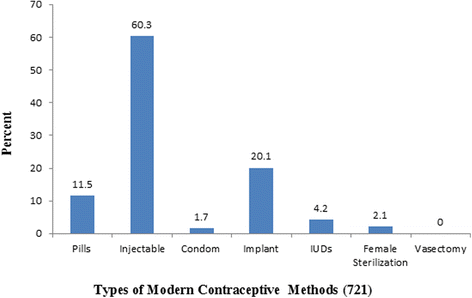Predictors of modern contraceptive methods use among married women of reproductive age groups in Western Ethiopia: a community based cross-sectional study
- PMID: 26183090
- PMCID: PMC4504461
- DOI: 10.1186/s12905-015-0208-z
Predictors of modern contraceptive methods use among married women of reproductive age groups in Western Ethiopia: a community based cross-sectional study
Abstract
Background: In Ethiopia, the prevalence of modern contraceptive use is very low (27 %) and the percentage of those with unmet needs for family planning is 25 %. The current study identified factors associated with the utilization of modern contraceptive methods among married women in Western Ethiopia.
Methods: A community based, cross-sectional study was employed from April 10 to April 25, 2014, among married women of reproductive age in Nekemte Town. A multi-stage sampling procedure was used to select 1003 study participants. A pretested structured questionnaire was used to collect data, and data collectors who had completed high school were involved in the data collection process. A bivariate, multivariable logistic regression model was fit, and statistical significance was determined with a 95% confidence level.
Result: The overall utilization rate of modern contraceptives in this study was 71.9%. The most common form of modern contraceptives used was injectable (60.3%). Age (AOR = 2.00, 95 % CI = 1.35-2.98), women's educational level (AOR = 2.50, 95 % CI = 1.62-3.84), monthly income (AOR = 2.26, 95 % CI = 1.24-4.10), respondent's fertility (AOR = 2.60, 95 % CI = 1.48-4.56), fertility-related decision (AOR = 3.70, 95 % CI = 2.45-5.58), and having radio (AOR = 1.93, 95 % CI = 1.37-2.71) showed significant positive associations with the utilization of modern contraceptive methods.
Conclusions: The findings showed that women's empowerment, fertility-related discussions among couples, and the availability of the media were important factors that influenced the use of modern contraceptives. Thus, policymakers and implementers should work on those factors to increase the utilization of modern contraceptive methods.
Figures
References
-
- Population Reference Bureau: Family Planning Saves Lives. 4th edition 2009. Available at: http://www.prb.org/pdf09/familyplanningsaveslives.pdf Accessed: June, 2014.
-
- United nation (UN) Millennium project public choices, private decisions. Sexual and reproductive health and the millennium development goals. New York: United Nations Development Programme; 2006.
-
- Littleton-Gibbs LY, Engebretson JC. Maternal, neonatal and women’s health nursing. 4. New York: Cengage Learning; 2004. pp. 310–3.
-
- World Health Organization (WHO): Update on family planning in sub-Saharan Africa. In Repositioning Family Planning. Guideline for Advocacy Action 2010. http://www.prb.org/Publications/Reports/2008/familyplanningadvocacytoolk... (accessed 5 May, 2014)
-
- Ross JA, Winfrey WL. Unmet need for contraception in the developing world and the former Soviet Union: an updated estimate. Int Fam Plan Prospect. 2002;28:138–43. doi: 10.2307/3088256. - DOI
Publication types
MeSH terms
Substances
LinkOut - more resources
Full Text Sources
Other Literature Sources
Medical
Miscellaneous



